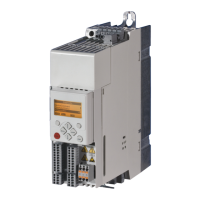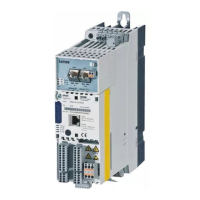8400 HighLine | Parameter setting & configuration
Motor control (MCTRL)
Encoder/feedback system
186 L Firmware ≤ 05.00 - DMS 4.2 EN - 02/2010
5.9.2 Encoder evaluation procedure
Depending on the encoder used, the following table specifies which evaluation method
should be selected in C00496
:
Tip!
• We recommend to use the preset combined encoder method (C00496
= 2).
• Use one of the first three procedures (C00496
= 0, 1, or 2) for dynamic
applications (e.g. operating mode: servo control).
• For dynamic speed control or positioning processes, use an HTL encoder with
1024 increments.
Selection in C00018 Encoder evaluation procedure
0: High-resolution encoder High-precision procedure for high-resolution encoders (>=512 increments)
• Method for speed measurement with automatic scan time setting
(0.5 … 500 ms).
• Evaluation with automatic scan time minimisation for an optimum dynamic
performance.
• Particularly suited for high-resolution encoders (≥ 1024 inc) with good signal
quality, i.e.
–good scanning ratio 1:1
–exactly 90°-phase offset between track A and B (error ≤±10°)
• Not suited for encoders with poor signal quality.
• Wiring according to EMC (e.g. motor and encoder cable shielding) is required!
1: Low-resolution encoder
(StateLine)
High-precision procedure for low-resolution encoders (<=128 increments)
• Exact method for speed measurement with automatic scan time setting
(0.5 … 500 ms) for low-resolution encoders in the range of 4 …. 128 increments.
• Evaluation with automatic scan time minimisation for an optimum dynamic
performance.
• Method is also suited for encoders with poor signal quality, e.g. for encoders with
high error rate in scanning ratio and phase offset.
• This method requires an equidistant period length per encoder increment.
• Wiring according to EMC (e.g. motor and encoder cable shielding) is required!
2: Comb. encoder method
(Lenze setting)
Combination of the first two procedures as a function of the speed (recommended
procedure)
• For a high-precision speed measurement suited for encoders with an arbitrary
number of increments (4 … 1024 increments).
• Low input frequencies at the encoder inputs:
The method is used for low-resolution encoders.
• High input frequencies at the encoder inputs:
The method is used for high-resolution encoders.
• This method is suited for encoders with average to good signal quality.
• Evaluation with automatic scan time minimisation for an optimum dynamic
performance.
• This method requires an equidistant period length per encoder increment.
• Wiring according to EMC (e.g. motor and encoder cable shielding) is required!
3: Edge-counting procedure Simple edge counting procedure with adjustable scan time (C00425
)
• Speed measurement by means of the edges of tracks A and B measured per
scanning interval.
• Integrated correction algorithm for EMC interference.
• Limited suitability for systems with unshielded encoder and/or motor cable.
• Limited suitability for encoders with poor signal quality, i.e. high error rate in
scanning ratio and phase offset.
efesotomasyon.com - Lenze

